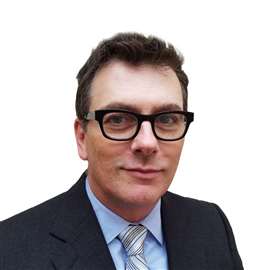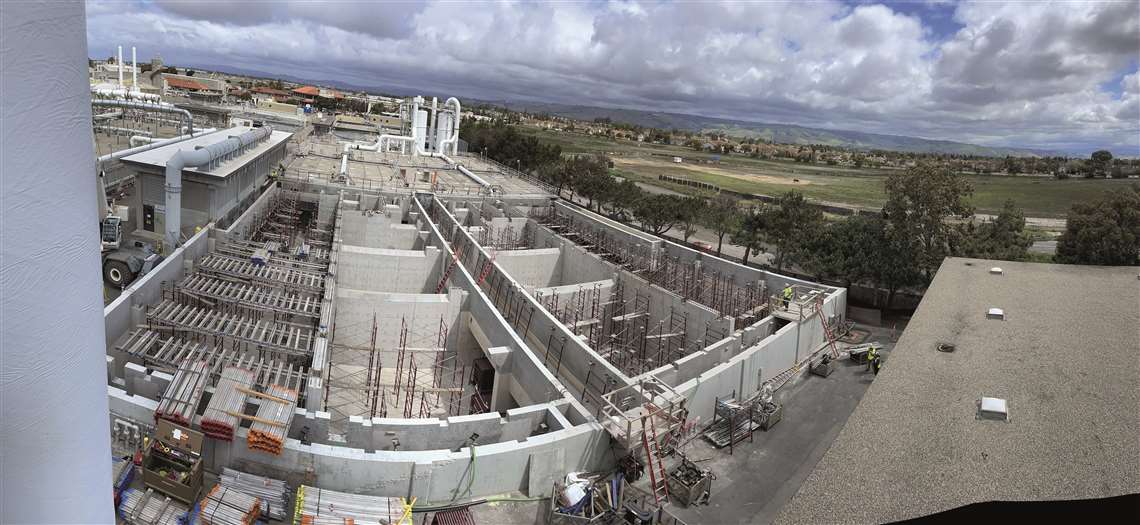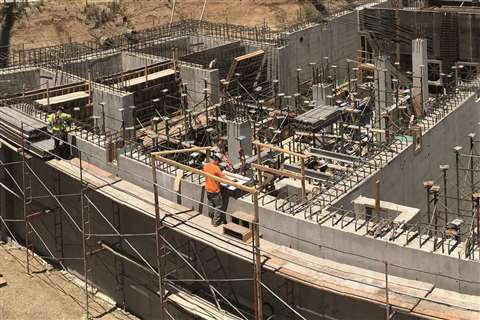
Project report: Shoring in Sacramento
21 March 2024
Read this article in Français Deutsch Italiano Português Español
Project report: Shoring in Sacramento
In October 2022, SkyLine Scaffold wrapped up its work on one of Sacramento’s largest public jobs in history – and took home the 2023 Scaffold & Access Industry Association’s Shoring Project of the Year Award for it.
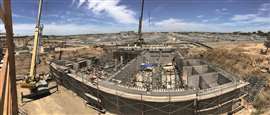 SkyLine Scaffold spent more than 52,000 hours erecting and dismantling 215,000 square feet of falsework and formwork on the project. (Photo: Frank Towse)
SkyLine Scaffold spent more than 52,000 hours erecting and dismantling 215,000 square feet of falsework and formwork on the project. (Photo: Frank Towse)
The EchoWater Project, a $1.8 billion, 12-year development, was in response to stringent nutrient removal and tertiary treatment requirements for treated wastewater issued by the California Regional Water Quality Control Board. Upon its completion in 2023, the California water treatment plant is now the second largest of its kind in the U.S.
Project scope and details
|
A brief look at SkyLine Scaffold Founded in 2005, SkyLine Scaffold is a woman- and family owned business based in Sacramento. The company has provided its services on a range of projects, from the Senate Floor and Governor’s Mansion in Sacramento to Grace Cathedral in San Francisco and inside the Burney Powerhouse. “We thrive in dealing with specialized jobs with stringent requirements — things like dam work or setting scaffold in mines,” the company says. “Our goal is to bring a lifetime of passion for scaffolding and shoring work to every project we undertake. “Scffolding isn’t easy — working on the side of a 25-story building with the wind blowing is challenging work that requires specialized skills and a fair amount of courage. But that’s exactly why we love it so much.” SkyLine Scaffold was awarded the 2023 Scaffold & Access Industry Association Award for the Shoring category for its work on the EchoWater Project. The SAIA Project Awards recognize member companies that have gone above and beyond in contributing to the overall success of a project within the scaffold and access industry. The 2024 awards are now open for entries, to find out more, visit www.saiaonline.org. |
In January 2019, SkyLine Scaffold was called upon to design and engineer the falsework to be used on the project, as well as supply all other related equipment, erect system supply and place formwork, and strip, dismantle and remove shoring for elevated concrete soffit, beam bottoms and sides, edge forms and guard railing for all 10 structures involved.
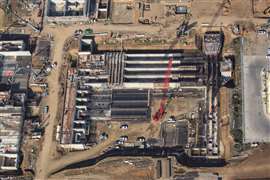 Upon its completion in 2023, the California water treatment plant is now the second largest of its kind in the U.S. (Photo: Frank Towse)
Upon its completion in 2023, the California water treatment plant is now the second largest of its kind in the U.S. (Photo: Frank Towse)
The company spent more than 52,000 hours erecting and dismantling 215,000 square feet of falsework and formwork over the course of SkyLine’s 2.5 years on the project, which ran through two winters and two grueling summers, the company says.
SkyLine employed 34 crew members with upwards of four foremen at any one time, to work on elevated concrete slabs and beams. Over the duration of the project, some 7,570 tons of rebar were placed, and 35 semi loads of shoring materials were delivered.
In collaboration with DHC Engineering and Dayton Superior, the $8 million contracted project was completed on time – and under budget (to the tune of $2 million.)
About the EchoWater Project
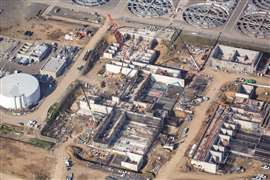 In January 2019, SkyLine Scaffold was called upon to design and engineer the falsework to be used on the project. (Photo: Frank Towse)
In January 2019, SkyLine Scaffold was called upon to design and engineer the falsework to be used on the project. (Photo: Frank Towse)
The EchoWater Project began in 2010 when the Central Valley Regional Water Quality Control Board issued new treatment requirements in Regional San’s wastewater discharge permit. A specific strategy was selected, engineering designs were completed and construction began.
“The massive upgrade consisted of 22 individual projects that together used 41,350 tons of steel and more than 225,000 cubic yards of concrete,” said the Sacramento Area Sewer District. “The centerpiece of the upgrade was the Biological Nutrient Removal (BNR) Project—the heart of the new treatment process. BNR is a sprawling complex, roughly equivalent in size to 18 football fields, and is responsible for removing 99 percent of ammonia and 89 percent of nitrogen, addressing concerns about possible impacts downstream.”
The Sacramento Area Sewer District added, “Making the project even more monumental, it came in on schedule and under budget. The original estimate projected costs to be as much as $2.1 billion. Regional San’s commitment to the success of the project and being fiscally responsible helped keep the final cost to about $1.7 billion—drastically reducing the impact to customers’ rates. The project was also awarded nearly $1.4 billion in low-interest financing from the state’s Clean Water State Revolving Fund, which saved ratepayers more than a half-billion dollars in interest costs.”
STAY CONNECTED



Receive the information you need when you need it through our world-leading magazines, newsletters and daily briefings.
CONNECT WITH THE TEAM


